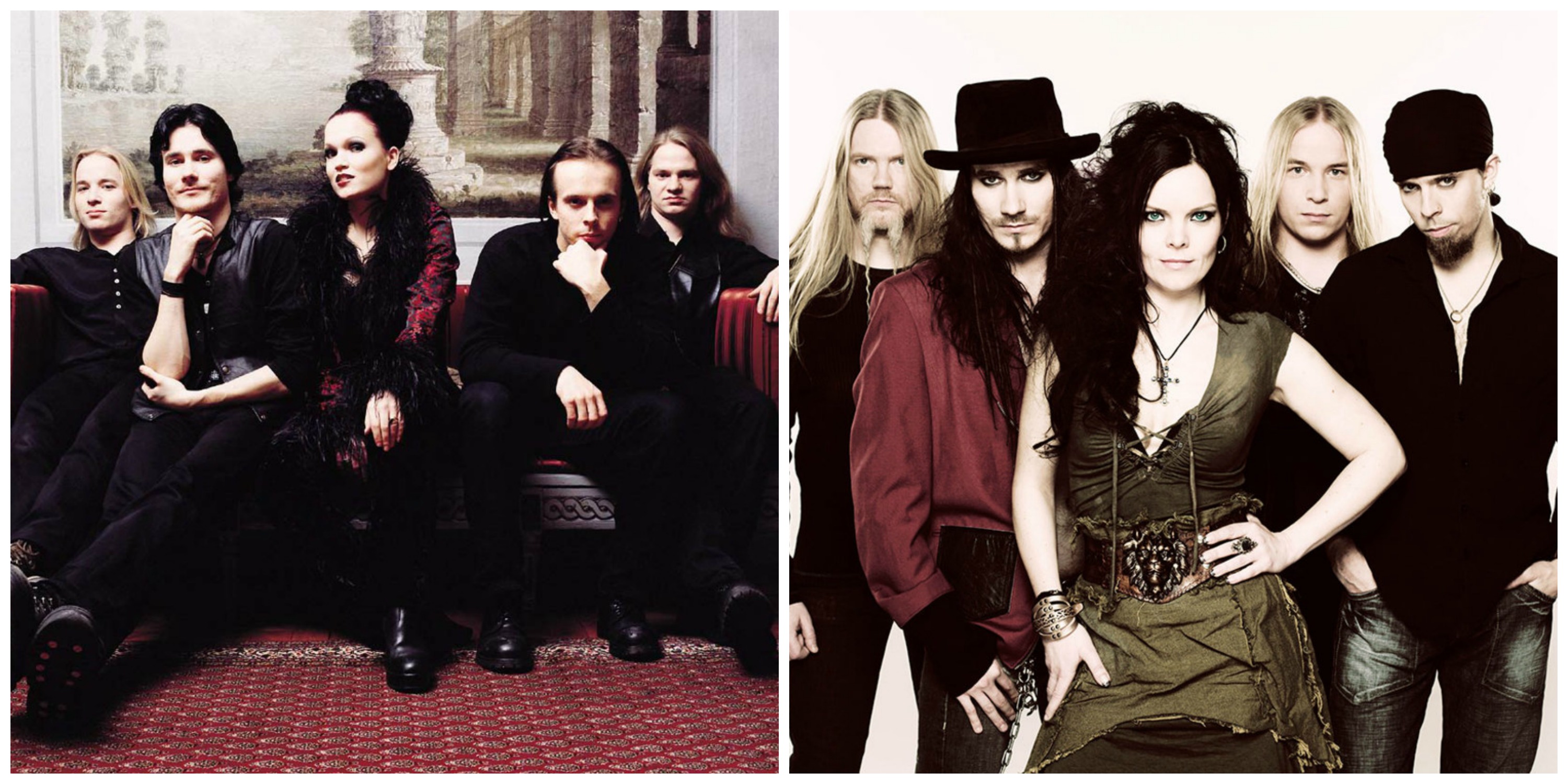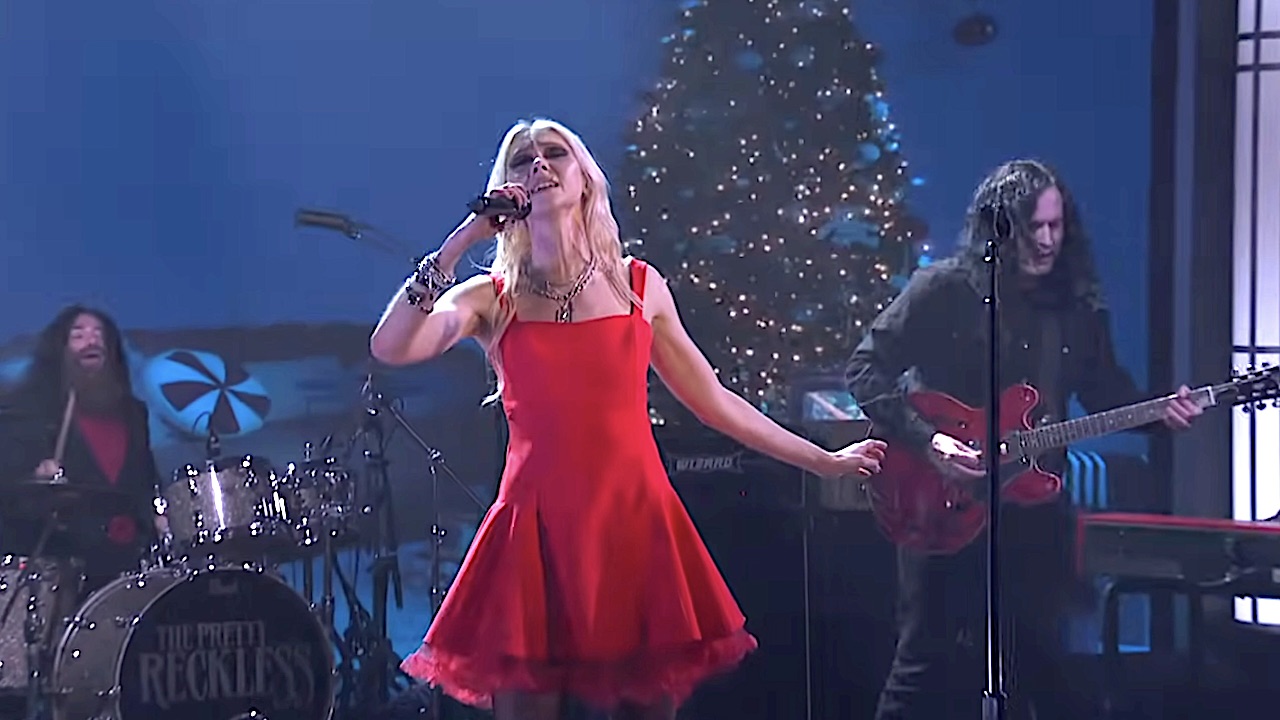A Night At The Opera: The Unstoppable Rise Of Nightwish
Meet the Finnish band bringing OTT operatics to heavy metal.

Oh, to have been a passer-by at Röskö campsite in Eastern Finland last summer. As the warm evenings drew in, the hordes of Boy Scout troupes that usually over-run the camp were absent. Instead their place was taken by several lavishly haired gentlemen (and one woman), who could be seen cracking open beers, firing up barbecues and bobbing on the campsite’s lake aboard inflatable crocodiles.
The people in question were the members of local heroes Nightwish, who had set up a makeshift studio on the campsite to record their eighth album, Endless Forms Most Beautiful. The bucolic surroundings were in stark contrast to the gothic, bombastic sound that has helped turn the Finnish band into unlikely stars./o:p
“Making music should be fun,” exclaims Tuomas Holopainen, Nightwish’s keyboard player and mastermind, and someone who, as a younger boy growing up nearby, was a member of one of those scout troupes who spent summer nights at Röskö. “That’s why we do it.”/o:p
The people in question were the members of local heroes Nightwish, who had set up a makeshift studio on the campsite to record their eighth album, Endless Forms Most Beautiful. The bucolic surroundings were in stark contrast to the gothic, bombastic sound that has helped turn the Finnish band into unlikely stars./o:p
“Making music should be fun,” exclaims Tuomas Holopainen, Nightwish’s keyboard player and mastermind, and someone who, as a younger boy growing up nearby, was a member of one of those scout troupes who spent summer nights at Röskö. “That’s why we do it.”/o:p
This cavalier attitude has helped get Nightwish where they are today. Over the course of their 20-year career they have transcended both their home country’s lack of real musical pedigree and the sniffiness of certain sections of the rock community to become flag-bearers for symphonic metal – that equally loved and maligned strand of classically inclined music that sees everything ratcheted up way past 11./o:p
If anyone embodies that whole genre, then it’s Nightwish. They have the corset-clad female singer, the lavish mix of traditional Euro-metal, Celtic-inspired folksiness and prog-tinged operatic ambition, and enough on-stage pyrotechnics to flatten a small city. If the Lord Of The Rings trilogy was a band, it would be Nightwish./o:p
Sign up below to get the latest from Classic Rock, plus exclusive special offers, direct to your inbox!
But then Holopainen is a man who revels in the over-the-top; nothing is too big or bonkers for him. And Endless Forms Most Beautiful takes it all to the next level. Not only does it weigh in at an epic, orchestra-laden 78 minutes (including a 24-minute closing track), it also features narration from controversial writer and philosopher Richard Dawkins. The album is big, bombastic and occasionally batshit-crazy./o:p
“We do music for selfish reasons,” he reasons. “We do it because it pleases us. And I think that’s the thing people most enjoy about Nightwish, because it is pompous, it’s theatrical, it’s even naive at times. But it’s always honest – it’s never following trends.”/o:p
This cavalier attitude has helped get Nightwish where they are today. Over the course of their 20-year career they have transcended both their home country’s lack of real musical pedigree and the sniffiness of certain sections of the rock community to become flag-bearers for symphonic metal – that equally loved and maligned strand of classically inclined music that sees everything ratcheted up way past 11./o:p
If anyone embodies that whole genre, then it’s Nightwish. They have the corset-clad female singer, the lavish mix of traditional Euro-metal, Celtic-inspired folksiness and prog-tinged operatic ambition, and enough on-stage pyrotechnics to flatten a small city. If the Lord Of The Rings trilogy was a band, it would be Nightwish./o:p
But then Holopainen is a man who revels in the over-the-top; nothing is too big or bonkers for him. And Endless Forms Most Beautiful takes it all to the next level. Not only does it weigh in at an epic, orchestra-laden 78 minutes (including a 24-minute closing track), it also features narration from controversial writer and philosopher Richard Dawkins. The album is big, bombastic and occasionally batshit-crazy./o:p
“We do music for selfish reasons,” he reasons. “We do it because it pleases us. And I think that’s the thing people most enjoy about Nightwish, because it is pompous, it’s theatrical, it’s even naive at times. But it’s always honest – it’s never following trends.”/o:p
When I first meet Holopainen he’s lying on the floor of his record label’s West London office, staring quietly up at the ceiling. Clad head-to-toe in black and sporting a precision-razored beard, he wouldn’t look out of place in the pages of an Anne Rice book (he has the deep, dark chocolate-coloured voice to match). As he contemplates whatever it is he’s contemplating, statuesque singer Floor Jansen strides over, offering a firm handshake and dwarfing her bandmate. /o:p
Holopainen grew up in Kitee, a small Finnish town famous primarily for “baseball, moonshine and Nightwish”. The youngest of three, he quickly became absorbed in classical music – playing piano and clarinet, and studying at music college. “We had to know Bach and Beethoven,” he says, having picked himself up off the floor and perched on a sofa. “I didn’t listen to much rock’n’roll. Then I discovered Gary Moore. That was a big thing for me.”/o:p
His tastes expanded to take in Queen and Metallica, although the most pivotal time of his life was a nine-month stint in the Finnish army when he was 18 as part of his compulsory national service. It was there, while playing clarinet in the military band, that he wrote what would become Nightwish’s first album, Angels Fall First. /o:p
“There’s that whole propaganda of ‘go to the army and become a man’,” he says. “I don’t believe that, from experience. I’m not a big army person. But I hit the lucky strike by getting into the military band, so I didn’t have to play with the guns and all that. And I had a lot of free time in the evenings.”/o:p
By the time of their second album, 1998’s Oceanborn, they had broken through in Finland. More importantly, Holopainen’s worldview had started to properly take shape – the influences of Tim Burton, Walt Disney and even surrealist painter Salvador Dali were starting to shine through. “I always see my songs as short movies,” he explains. “That’s where the cinematic side of it comes from.”/o:p
Endless Forms Most Beautiful is where every strand of Holopainen’s interests come together. It’s a pivotal album for Nightwish. Not only because of its sheer magnitude, but also because it’s their first with Jansen, who stepped in as a temporary member in 2012 after the sudden departure of her predecessor, Anette Olzon (below right), mid-tour. For Jansen, a classically trained soprano and formerly a member of Dutch operatic metal band After Forever, her first show was a baptism of fire. “I was terrified,” she confesses. “I had forty-eight hours to study a ninety-minute set-list.”/o:p
Jansen’s arrival and eventual hiring as a full-time member in 2013 was just the latest episode in an off-stage soap opera that is at odds with Nightwish’s grandoise music. Olzon’s departure was less than amicable, as was the split with original singer Tarja Turunen (below left) in 2005, which saw both sides airing their dirty laundry in the press and online. As a result, it’s been suggested that Holopainen is some sort of dictator with a habit of falling out with his leading ladies. His default setting is to point people towards previous statements which explain the singers’ departures (from Nightwish’s point of view, admittedly)./o:p
Today all he will say is that the vibe within the band is good. “We’ve had moments with the previous singers like that as well, of course we have. But it is as good as it has ever been now.”/o:p

| <![endif]> <![if !mso]> |
ORCHESTRAL MANOEUVRES IN THE DARK
Your five track Nightwish primer
Sleeping Sun/o:p
Most musicians are inspired to write ballads about the people they love. Not Tuomas Holopainen. Nope, the Nightwish man dedicated this dark yet twinkling stand-alone 1999 single to that year’s solar eclipse. /o:p
Bless The Child/o:p
Graveyard, forests, a dark wedding scene – few thing sum up the gothic-romantic Nightwish M.O. like the video to this Tarja Turunen-fronted single, taken from 2002’s Century Child. The point at which Holopainen’s bombastic vision became a choir-quaking, symphonic metal reality./o:p
Wish I Had An Angel/o:p
The big single from of Tarja’s swansong album, 2004’s Once, finds the singer trading lines with Viking-esque bassist and co-vocalist Marco Hietala. The resulting anthem, complete with pulsing, dancefloor friendly bassline, remains a live favourite./o:p
Storytime/o:p
Holopainen’s mad-scientist vision came to full fruition on 2012’s Imaginaerum – an ode to all things fantastical, with its own spin-off movie. This single was a magnificent match of orchestra and metal, even if soon-to-depart singer Anette Olzon’s voice lacked a little oomph./o:p
Dark Chest Of Wonders (Live At Wacken)/o:p
Exit Olson, enter third singer Floor Jansen – just in time for a headlining slot at the big daddy of European metal festivals. Layered to the nines in leather, the Dutchwoman made easy work of this Turunen-era anthem. The rest is history./o:p
Symphonic Metal Special: Epica, Delain and the queens of the corset

Polly is deputy editor at Classic Rock magazine, where she writes and commissions regular pieces and longer reads (including new band coverage), and has interviewed rock's biggest and newest names. She also contributes to Louder, Prog and Metal Hammer and talks about songs on the 20 Minute Club podcast. Elsewhere she's had work published in The Musician, delicious. magazine and others, and written biographies for various album campaigns. In a previous life as a women's magazine junior she interviewed Tracey Emin and Lily James – and wangled Rival Sons into the arts pages. In her spare time she writes fiction and cooks.
